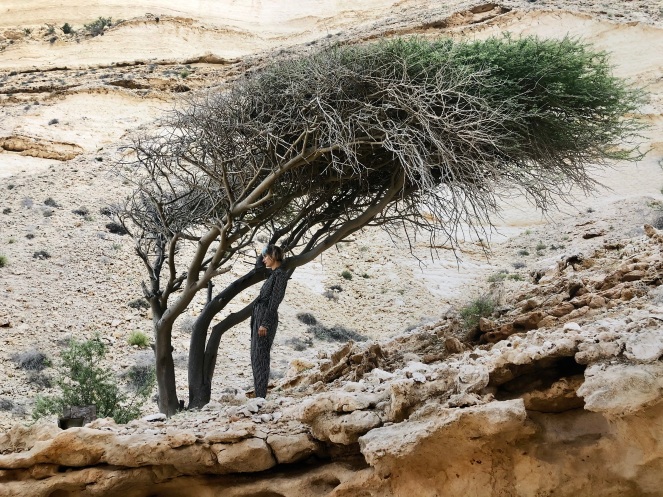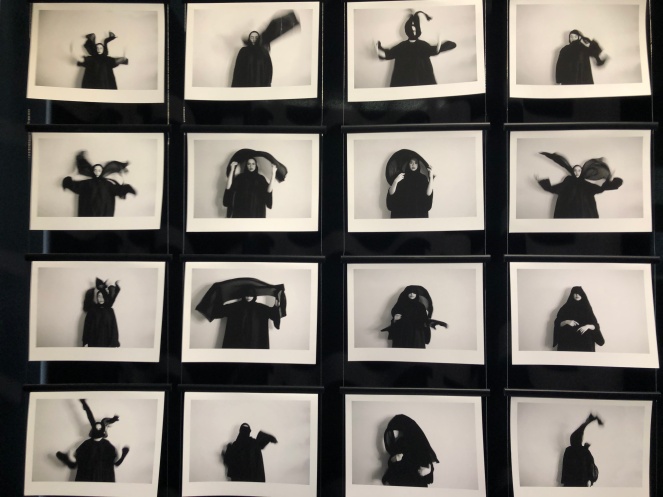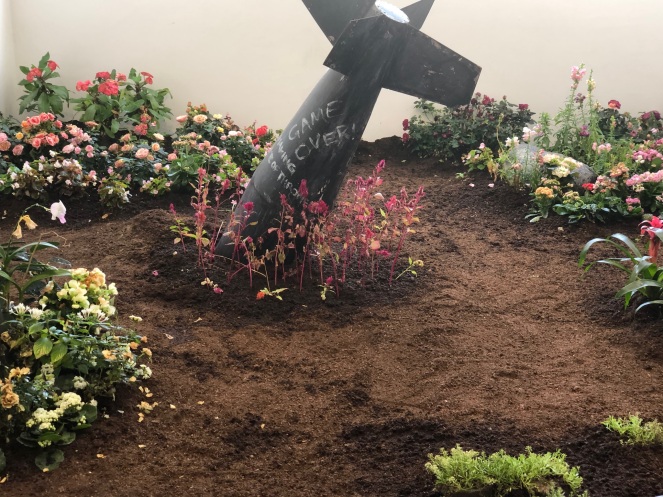 Pic. 1: ‘Arabian Landscape with a North European Woman Trying to Blend in (Tree), 2019, colour photograph’ by Elina Brotherus. Photo©Dia Mexi-Jones
Pic. 1: ‘Arabian Landscape with a North European Woman Trying to Blend in (Tree), 2019, colour photograph’ by Elina Brotherus. Photo©Dia Mexi-Jones
The Stal Gallery in Muscat, in collaboration with the British Council, presents the Wapping project exhibition with the title ‘Resonance.’ The Wapping Project, a London-based art organization, has commissioned four Omani and one Finnish artist to create artworks and exhibit them at the Stal Gallery in Muscat. This show is the beginning of a peripatetic exhibition using the same title but with local artists from each GCC country. The title ‘Resonance’ is by itself an intelligent choice; it has a twofold meaning; in physics, it means ‘sound reverberation’, and its literal meaning is ‘makes something personally meaningful or important’. A brilliant title for an art exhibition, since it applies to both artists and audience engagement. But let’s see how successful was this engagement.
At the entrance of the Gallery, there is an imposing life-size picture of the five female artists wearing dark colour trousers and holding on their faces a stick like a moustache. An image that brought in my mind the famous poster of the Guerrillas Girls’ “Do Women Have to be Naked to Get into the Met?”. In this case, the girls pass a similar message that could be interpreted as “Do We need to be Disguised as Men to Exhibit our Artwork?”
The interior space of the Gallery has a theatrical ambience. Black curtains have covered all the Gallery’s walls, and the artworks are hanging on them by a piece of string. This curatorial innovation catches the visitor by surprise and increases the curiosity to see what’s next.
The first artwork that the visitor comes across is Elina Brotherus’ photo of the Omani landscape with her figure blended in it (pic.1). Brotherus is a Finnish artist living in France. Her artwork focuses on photography and moving image. She has been inspired by the Fluxus movement using score events (written instructions for performance-oriented art of the 1950s-70s). In this particular project, Brotherus works as a mentor to the local artists and uses event scores that come from the American Fluxus Conceptual artist John Baldessari.
Based on this concept, the five artists developed their artwork during their residency. Brotherus’ series of photographs ‘regle de jeu = rules of the game’ have a cheerful effect on the visitors’ senses. Her figure plays the ‘hide and seek’ game with Oman’s landscape. Sometimes it is predominant, and others it is blended carefully with the beautiful colours of the scene. She has managed to entrap in her photos the unique yellowish and greenish hue of Oman’s landscape, which differentiates it from the rest of the GCC desert-like landscapes. Her beautiful coloured pictures with the joyful theme created a contrast to the gloomy atmosphere of the Gallery. Still, at the same time, it generates a stimulating juxtaposition with the rest of Omani’s artworks.
The four Omani artists found their inspiration in their local culture and their identity and status inside this society. Through the event scores process, they have created artworks with bold messages. Next to Brotherus’s Omani’s landscape image there is the video of the Omani artist Ruqaiya Mazar, a graduate from the University of Nizwa with an emphasis on photography, video and digital art, presents videos and photographs that portray the society’s demands on the individual and particularly on women in this society. She intelligently creates artworks that pass the messages clearly about all the constraints and barriers a female has to anticipate in her community. Her video with the title “When They See Me (Why? Why Not)” depicts herself covered by a see-through scarf answering back to all the voices in the Arabic language around her with a simple word “Halas,” in loose translation “ok, I obey.” The latter word stops any debate between the agents (female or male) and the institution of the family. Also, it terminates any change of certain gendered expectations in this society. Rules made not to be broken.
In the next space of the Gallery, there are the photographs of Rawan Almahrouqui, a graduate from Sultan Qaboos University. She focuses on the female experience in the Arabian Gulf and the double standards, the thin line between tradition and religion. Rawan’s series of photographs with the title ‘Me and My Scarf’ (pic.2), it’s a series of multiple photos of gestures, a choreography of gestures with her scarf, hiding her eyes, her mouth or transformed it to a struggling rope. It’s almost like the classroom activity of ‘show and tell’ without words but photographs—a game of gestures that releases more a sense of passive-aggressiveness rather than joy.
 Pic.2: ‘Me And My Scarf’, 2020 series of 20 b&w photographs by Rawan Almahrouqi. Photo:© Dia Mexi-Jones
Pic.2: ‘Me And My Scarf’, 2020 series of 20 b&w photographs by Rawan Almahrouqi. Photo:© Dia Mexi-Jones
Safa Baluchi, a graduate from Nizwa University with a BA in Spatial design, works across performance, video, photography, and installation. She won the Young Emerging Artist Prize run by Stal Gallery in Muscat. As with the previous Omani artists, her artwork explores the individual in Arabic society. Her videos with herself as the main protagonist using as a tool her scarf or stones from the beach washing both of them diligently. This procedure reminded me of Vronsky, Tolstoy’s character in Anna Karenina, who was referring to the word laundry “I’m going to make my laundry” when he was isolating to put his feelings and thoughts in order. Safa uses the same concept to clean her guiltiness for not doing the right thing according to the demands of her society. Safa’s brilliant conceptual art is using the appropriate semiotics, red scarf, and bucket as carriers of her guiltiness.
All the above artists’ works are concentrated in the area of domesticity, which is traditionally female terrain to present their art projects except Riham Noor Al Zadjali, a graduate in Fine Arts from Paris American Academy with a focus on current global events, war, immigration. Her installation ‘They Will Welcome Us With Flowers’ (pic.3) made up with a real garden with beautiful flowers, and among them metallic look like missiles written on them various messages. An installation that clarifies any misconception about war, where rockets are killing civilians and destroying their homes. Riham moves further to this of Martha Rosler’s collage ‘Beautiful Home'(1967), where she connected the ‘there’ war in Vietnam and the ‘here,’ the American homes in the USA. She creates a real garden to raise awareness about what the soldiers thought about going to serve their country and what happened by shooting the deadly missiles. She manages well to deliver the message of this grave fact with a sense of humour and irony and puts a real smile on the face of the visitor by reading on the metallic missiles messages like “look here smile for flash,” “game is over!”, “special delivery!”.
All the artists make strong statements by using their identity in their artworks. They transform their female body from object to subject as Lucy Lippard wrote: “when women use their own bodies in their artwork, they are using their selves; a significant psychological factor converts these bodies or faces from object to subject”. They brilliantly resonate their messages to the audience and their uneasiness with the constraints that their society imposes on them. All four of them are a breath of fresh air ready to take on board all the young people who may have similar existential thoughts. Impressively, the Northern European artist did not patronize the local appearance; she tried to blend with them and show another side of existence.
 Pic.3: ‘They Will Welcome Us With Flowers’, 2020, installation, metal missiles, flower garden by Riham Noor Al Zadjali. © Dia Mexi-Jones
Pic.3: ‘They Will Welcome Us With Flowers’, 2020, installation, metal missiles, flower garden by Riham Noor Al Zadjali. © Dia Mexi-Jones
The only drawback of this exhibition and the reason which maybe will not comply with the chosen title ‘Resonance’ and succeed to spread the message to the broader community is the curatorial approach. The black curtains surrounding the whole exhibition are a formidable semiotic artistic trick (the semiotic of abayas). Still, it created a gloomy atmosphere that needed desperately to be enhanced with more explanation and interpretation of the artworks to keep the audience engaged on the spot. Since we are in the era of educational turn in curating and the most critical leading art exhibitions, show the way how to present the conceptual art (see Documenta, Biennale), where the storytelling and explanation are an essential part of the display. Indeed, there was the exhibition’s brochure, which supported it with texts and other interpretations of the whole show. Still, I think it was insufficient, especially for this audience in this country. I felt it needed more description with labels and panels to keep more engaged with the audience. The art world has moved from the era of the white cube curatorial concept to that of the educational. In our times, since there is minimum schooling about art in the schools replaced by science, art exhibitions are the single source of art education. Overall, I think it was a brave step forward for the art projects in this area, and the Omani artists have shown signs of great audacity precisely what one needs from the art people. They are taking the leading role in moving the society forward through the medium of thoughtful reflection on the community and the world they live in.
Written by Dia Mexi-Jones, an independent curator based in London & Muscat
Resonance Exhibition
4 March – 2 April 2020
Stal Gallery, Muscat
 The innovation of Documenta14 did not lie in the fact that it happened equally in two cities. Documenta 11 and 13 had not taken place in cities other than Kassel, nor was it that the highest percentage of the artists came from the periphery of the Western world. Documenta12 had a high rate of artists from the periphery. The same concept had been already shown in the exhibition Magiciens de la Terre in 1989 at the Centre Georges Pompidou by the curator Jean-Hubert Martin – a theme about post-colonialism with artists from the periphery of the Western art world (Magiciens de la Terre, 2017). The innovation laid firstly in the fact that this Documenta supported a large number of artists who were not represented by commercial galleries and they worked in non-material, ephemeral and social practices. Documenta14 embedded fully the curatorial activism as defined by Maura Reilly ᾽to give voice to those who have been historically silenced or omitted altogether’ (2017). Secondly, the working relationship between the artistic director, his team and the artists was cooperative; the artistic director and the team took care to listen closely and carefully to the artists, rather than imposing a top-down curatorial will as the artists by themselves stated that we understood this exhibition to be a listening documenta’ (E-Flux conversations, 2017a). Thirdly, it was an apatride exhibition, at least in the Athens exhibition, in that there were no dates and place of birth/origin of the artists, an idea that the artists themselves asked for (Stedelijk Museum, 2016). Fourthly, it concentrated on the language and stories that each artist from the periphery had faced and the hardship they had overcome. The artists had to bring their personal stories in every form, artwork, performance, music, into the exhibition and tried to be inclusive as well as specific, which means they had to concentrate on the dominant narrative of the Athens model and on the complex narrative, which was that of Athens and Kassel. The juxtaposition of stories from all over the globe could be disorienting but was precisely the point of the structure of this exhibition (E-Flux conversations, 2017a). Finally, the event was part of a process of acquiring experience for all the participants; this fact could erase any claim and criticism of the reviewers about the event. For example, one of the reviewers, Sarah Crown, wrote about the banned books in The Parthenon of Books ‘by being pinned and mounted salon style, the volumes became untouchable and unreadable symbols, which is precisely what the fascists made of them’ (Cowan, 2017). In the last week of the exhibition, all those books were given out for free to the visitors. This high complexity of the show in real time created an interesting fact that nobody could have seen the same thing and even if that happened the time would have changed the initial impression. Nothing is static, precisely as the people interact in the virtual world on the Internet.
The innovation of Documenta14 did not lie in the fact that it happened equally in two cities. Documenta 11 and 13 had not taken place in cities other than Kassel, nor was it that the highest percentage of the artists came from the periphery of the Western world. Documenta12 had a high rate of artists from the periphery. The same concept had been already shown in the exhibition Magiciens de la Terre in 1989 at the Centre Georges Pompidou by the curator Jean-Hubert Martin – a theme about post-colonialism with artists from the periphery of the Western art world (Magiciens de la Terre, 2017). The innovation laid firstly in the fact that this Documenta supported a large number of artists who were not represented by commercial galleries and they worked in non-material, ephemeral and social practices. Documenta14 embedded fully the curatorial activism as defined by Maura Reilly ᾽to give voice to those who have been historically silenced or omitted altogether’ (2017). Secondly, the working relationship between the artistic director, his team and the artists was cooperative; the artistic director and the team took care to listen closely and carefully to the artists, rather than imposing a top-down curatorial will as the artists by themselves stated that we understood this exhibition to be a listening documenta’ (E-Flux conversations, 2017a). Thirdly, it was an apatride exhibition, at least in the Athens exhibition, in that there were no dates and place of birth/origin of the artists, an idea that the artists themselves asked for (Stedelijk Museum, 2016). Fourthly, it concentrated on the language and stories that each artist from the periphery had faced and the hardship they had overcome. The artists had to bring their personal stories in every form, artwork, performance, music, into the exhibition and tried to be inclusive as well as specific, which means they had to concentrate on the dominant narrative of the Athens model and on the complex narrative, which was that of Athens and Kassel. The juxtaposition of stories from all over the globe could be disorienting but was precisely the point of the structure of this exhibition (E-Flux conversations, 2017a). Finally, the event was part of a process of acquiring experience for all the participants; this fact could erase any claim and criticism of the reviewers about the event. For example, one of the reviewers, Sarah Crown, wrote about the banned books in The Parthenon of Books ‘by being pinned and mounted salon style, the volumes became untouchable and unreadable symbols, which is precisely what the fascists made of them’ (Cowan, 2017). In the last week of the exhibition, all those books were given out for free to the visitors. This high complexity of the show in real time created an interesting fact that nobody could have seen the same thing and even if that happened the time would have changed the initial impression. Nothing is static, precisely as the people interact in the virtual world on the Internet. Elisabeth Wild, Fantasias, 2016–17, collages, installation view, Neue Galerie, Kassel, documenta 14, pic. Dia Mexi, 2018
Elisabeth Wild, Fantasias, 2016–17, collages, installation view, Neue Galerie, Kassel, documenta 14, pic. Dia Mexi, 2018